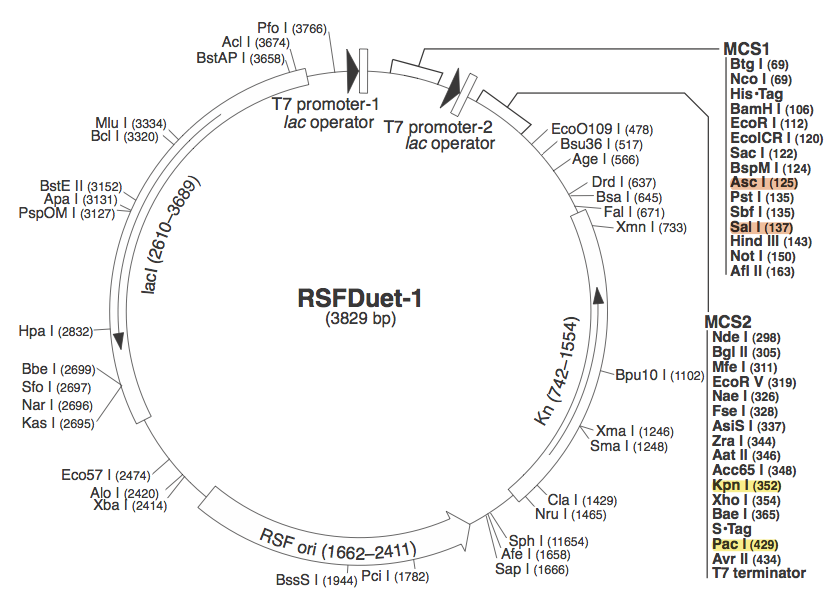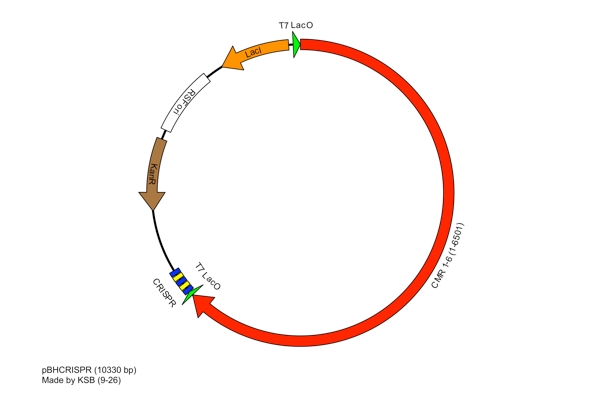Team:Arizona State/Project/B halodurans
From 2011.igem.org
(Created page with "{{:Team:Arizona State/Templates/main|title=Bacillus|content= __NOTOC__ ==Bacillus halodurans== Image: ASU_pBhCRISPR.jpg The plasmid containing CRISPR derived from Bacillus...") |
|||
| Line 2: | Line 2: | ||
__NOTOC__ | __NOTOC__ | ||
| - | == | + | ==Conception== |
| + | (Insert text here) | ||
| + | |||
| + | ==Design== | ||
| + | ===Flowchart=== | ||
| + | |||
| + | This is the experimental flowchart for the construction of our B. halodurans CRISPR platform. | ||
| + | |||
| + | [[Image: ASU_Bh_flowchart.png]] | ||
| + | |||
| + | Beginning from the right-hand side of the diagram, this image outlines each step of the construction of our synthetically directed, RNA-targeting B. halodurans CRISPR-Cas construct. In short: | ||
| + | |||
| + | <b>Step 1)</b> Construct RSR arrays with one of two methods: | ||
| + | :*Traditional restriction, ligation, transformation of Repeat sequence and Spacer-Repeat sequence | ||
| + | :*Six overlapping oligos | ||
| + | <br> <b>Step 2)</b> Ligate B. halodurans leader sequence to RSR array | ||
| + | <br> <b>Step 3)</b> PCR amplify Cas genes (Cmr1-6) | ||
| + | <br> <b>Step 4)</b> Insert both the array and the Cas genes into plasmid with two multiple cloning sites (pRSF Duet) | ||
| + | |||
| + | ===pRSF Duet=== | ||
| + | |||
| + | [[Image: ASU_pRSF2.png|500px]] | ||
| + | |||
| + | We chose to use pRSF Duet from Novagen as the vector for our construct because it has two multiple cloning sites (MCS1 and MCS2). It was used in a CRISPR study (cite, is this Brouns?). In the image above, the restriction sites for each component of our construct are highlighted. | ||
| + | |||
| + | <br><b>Red</b> - Cmr1-6 | ||
| + | <br><b>Yellow</b> - Leader+RSR | ||
| + | |||
| + | <p>These restriction sites were specifically chosen because they do not fall within the Cas, Leader, or RSR sequences. This was confirmed using [http://tools.neb.com/NEBcutter2/ NEB Cutter].</p> | ||
| + | |||
| + | ===Our Plasmid=== | ||
| + | |||
| + | Completing each of these steps yields this plasmid: | ||
[[Image: ASU_pBhCRISPR.jpg]] | [[Image: ASU_pBhCRISPR.jpg]] | ||
The plasmid containing CRISPR derived from Bacillus halodurans includes the CMR region. In addition, it includes a leader sequence corresponding to B. halodurans CRISPR constructs, which is adjacent to our GFP-targeting Repeat/Spacer array. | The plasmid containing CRISPR derived from Bacillus halodurans includes the CMR region. In addition, it includes a leader sequence corresponding to B. halodurans CRISPR constructs, which is adjacent to our GFP-targeting Repeat/Spacer array. | ||
| + | |||
| + | ==Construction== | ||
| + | ===Repeat-Spacer Array=== | ||
| + | <p>Originally, we envisioned the Repeat-Spacer-Repeat (RSR) array as an easily manipulatable, modular, BioBrick-compatible component with restriction sites flanking the spacer. This would mean that once a functional CRISPR construct is constructed, all it would take is a simple restriction and ligation to insert a spacer of one's choice that corresponds to a gene of one's choice. Thus, we constructed two potential BioBricks:</p> | ||
| + | |||
| + | "<b>RA</b>": BB Prefix, Restriction Site #1 inside anti-GFP Spacer, Restriction Site #2, B. halodurans Repeat Sequence, Suffix | ||
| + | <br>"<b>RB</b>": BB Prefix, B. halodurans Repeat Sequence, Suffix | ||
| + | |||
| + | <p>The idea here was to connect multiple <b>RA</b> inserts and cap the construct with a <b>RB</b> insert, effectively creating an array of any given length. However, upon further examination of CRISPR literature, it was hypothesized that the scars left by restrictions and ligations would impede proper hairpinning and Cascade interaction of transcribed cRNA.</p> | ||
| + | |||
| + | <p>So, we then took a different and more budget-friendly assembly approach: overlapping oligos.</p> | ||
| + | |||
| + | (more here) | ||
| + | |||
| + | ===Leader+RSR=== | ||
| + | Discuss leader (BioBrick), any assembly? | ||
| + | |||
| + | ===Cas genes=== | ||
| + | Success! | ||
| + | (image+caption) | ||
| + | |||
| + | ==Future== | ||
| + | ===Advantages of RNA-targeting CRISPR=== | ||
| + | Lots of potential cool applications of this... list them? | ||
| + | ===Overcoming Tandem Repeat Issues=== | ||
| + | Discuss this, similar to E. coli... do overlapping oligos solve this at all? | ||
| + | |||
}} <!-- close content attribute for menubar --> | }} <!-- close content attribute for menubar --> | ||
Revision as of 23:48, 28 September 2011
|
|
Conception(Insert text here) DesignFlowchartThis is the experimental flowchart for the construction of our B. halodurans CRISPR platform. Beginning from the right-hand side of the diagram, this image outlines each step of the construction of our synthetically directed, RNA-targeting B. halodurans CRISPR-Cas construct. In short: Step 1) Construct RSR arrays with one of two methods:
pRSF DuetWe chose to use pRSF Duet from Novagen as the vector for our construct because it has two multiple cloning sites (MCS1 and MCS2). It was used in a CRISPR study (cite, is this Brouns?). In the image above, the restriction sites for each component of our construct are highlighted.
These restriction sites were specifically chosen because they do not fall within the Cas, Leader, or RSR sequences. This was confirmed using NEB Cutter. Our PlasmidCompleting each of these steps yields this plasmid: The plasmid containing CRISPR derived from Bacillus halodurans includes the CMR region. In addition, it includes a leader sequence corresponding to B. halodurans CRISPR constructs, which is adjacent to our GFP-targeting Repeat/Spacer array. ConstructionRepeat-Spacer ArrayOriginally, we envisioned the Repeat-Spacer-Repeat (RSR) array as an easily manipulatable, modular, BioBrick-compatible component with restriction sites flanking the spacer. This would mean that once a functional CRISPR construct is constructed, all it would take is a simple restriction and ligation to insert a spacer of one's choice that corresponds to a gene of one's choice. Thus, we constructed two potential BioBricks: "RA": BB Prefix, Restriction Site #1 inside anti-GFP Spacer, Restriction Site #2, B. halodurans Repeat Sequence, Suffix
The idea here was to connect multiple RA inserts and cap the construct with a RB insert, effectively creating an array of any given length. However, upon further examination of CRISPR literature, it was hypothesized that the scars left by restrictions and ligations would impede proper hairpinning and Cascade interaction of transcribed cRNA. So, we then took a different and more budget-friendly assembly approach: overlapping oligos. (more here) Leader+RSRDiscuss leader (BioBrick), any assembly? Cas genesSuccess! (image+caption) FutureAdvantages of RNA-targeting CRISPRLots of potential cool applications of this... list them? Overcoming Tandem Repeat IssuesDiscuss this, similar to E. coli... do overlapping oligos solve this at all? |
 "
"



